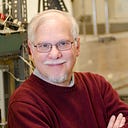My Great Grandmother’s Candlesticks — ruminations on geologic and personal time
At the beginning of the Jewish New Year last week I lit candles to mark the day. The candlesticks I used were my maternal great grandmothers, brought with her to America in 1910. These were passed to my grandmother, then to my mother, and finally to me and my family. Staring at the candles connected me to an ancestor I had never met; I only know of her from a single photograph and the stories my grandmother and mother told. Of my other great grandparents, I know even less, just names and photos. But I am connected to them also. They exist in genealogic deep time, the personal equivalent of the immense span of geologic time that I study as a paleontologist.
But the candlesticks represent a deeper connection. They were lit on every Sabbath for at least a century. The weekly celebration of the Sabbath, the annual observance of the festivals and holidays, tie me to my ancestors who observed the same events, back through centuries. As observed by my rabbi Max Weiss in this year’s Rosh Hashanah sermon, there are two types of time in Judaism. The first is the personal and historic, the movement from birth to death and the history of our people and humanity. This time is directional. The second is the annual repetition of the holidays and months. This time is cyclical. Together, they are a spiral, both going around and moving forward. And as my rabbi mentioned, recognizing this helps root us when, due to the pandemic, we feel unrooted in time (it’s already September? Is today Monday or Tuesday?).
Geologic time is also a spiral. The physical Earth has changed tremendously since its origin some 4.5 billion years ago. Continents and oceans have formed, the atmosphere changed from one with no oxygen to one that could support breathing. Seas have covered the continents and later withdrawn. Huge mountain ranges formed, only to be eroded away. Life originated and evolved to produce what Darwin called “endless forms most beautiful.” Organisms that dominated the biosphere, such as trilobites and dinosaurs, appeared and disappeared. When looking at the Earth, time has a direction, what Steve Gould called the “arrow of time.”
But geology also has many cycles. One of the most fundamental concepts is the rock cycle, with the movement of rock from the surface to the interior and returning to the surface, changing from sedimentary to metamorphic to igneous and back again. Carbon moves in many cycles between the atmosphere, oceans, life, and solid rock. And as Solomon observed so long ago, “All the rivers flow into the sea, Yet the sea is not full. To the place where the rivers flow, there they flow again.” Even the ancients knew of the water cycle. And we know that long cyclic changes of the Earths’ orbit, that can take 10’s or 100’s of thousands of years, have controlled the advance and retreat of the ice sheets that until recently covered the Northern Hemisphere.
One of the key lessons of geology and paleontology is that the world is not only a product of what is happening today but is the result of what has happened before. We have breathable air because photosynthesis evolved. Mammals and birds dominate the land because the bird’s dinosaur ancestors perished. The landscape of Chicago, where I live, is the product of the glaciers that once covered the area. We are rooted in geologic time.
In the same way, my own life is the product of not only what I do but of what came before. Every time I hear the news from Ukraine or Belarus, I silently thank my grandparents for coming to this country. When I think about my education, I thank my late parents who sacrificed so I could attend college and who supported me in every way possible. And as I do when the year’s cycle comes back to this time, I work hard to remember them. They are gone, but the candlesticks remain to remind me of them and to root me in personal time.
